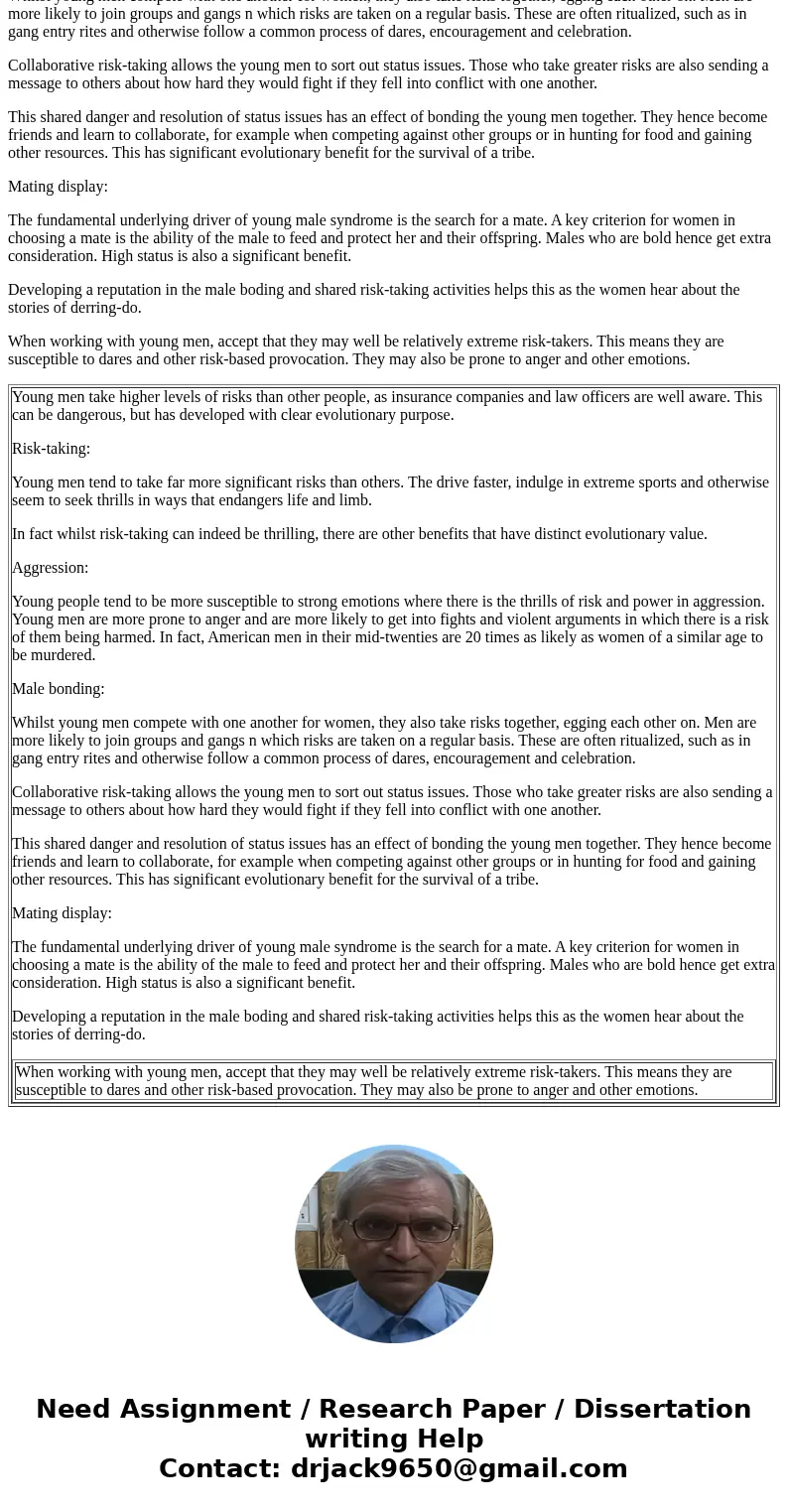Evolutionary Psychology Buss David M 2015 I think one of th
Evolutionary Psychology - Buss, David M. (2015)
I think one of the more interesting sections in Chapter 10 involves \"The Young Male Syndrome\" (pp. 307-9). Discuss your experience as it relates to this topic. Does it converge with or diverge from the research and theory presented?
Solution
Answer:
Sexual selection theory suggests that willingness to participate in risky or violent competitive interactions should be observed primarily in those age-sex classes that have experienced the most intense reproductive competition (fitness variance) during the species evolutionary history, and In those individuals whose present circumstances are predictive of reproductive failure.
Young men take higher levels of risks than other people, as insurance companies and law officers are well aware. This can be dangerous, but has developed with clear evolutionary purpose.
Risk-taking:
Young men tend to take far more significant risks than others. The drive faster, indulge in extreme sports and otherwise seem to seek thrills in ways that endangers life and limb.
In fact whilst risk-taking can indeed be thrilling, there are other benefits that have distinct evolutionary value.
Aggression:
Young people tend to be more susceptible to strong emotions where there is the thrills of risk and power in aggression. Young men are more prone to anger and are more likely to get into fights and violent arguments in which there is a risk of them being harmed. In fact, American men in their mid-twenties are 20 times as likely as women of a similar age to be murdered.
Male bonding:
Whilst young men compete with one another for women, they also take risks together, egging each other on. Men are more likely to join groups and gangs n which risks are taken on a regular basis. These are often ritualized, such as in gang entry rites and otherwise follow a common process of dares, encouragement and celebration.
Collaborative risk-taking allows the young men to sort out status issues. Those who take greater risks are also sending a message to others about how hard they would fight if they fell into conflict with one another.
This shared danger and resolution of status issues has an effect of bonding the young men together. They hence become friends and learn to collaborate, for example when competing against other groups or in hunting for food and gaining other resources. This has significant evolutionary benefit for the survival of a tribe.
Mating display:
The fundamental underlying driver of young male syndrome is the search for a mate. A key criterion for women in choosing a mate is the ability of the male to feed and protect her and their offspring. Males who are bold hence get extra consideration. High status is also a significant benefit.
Developing a reputation in the male boding and shared risk-taking activities helps this as the women hear about the stories of derring-do.
When working with young men, accept that they may well be relatively extreme risk-takers. This means they are susceptible to dares and other risk-based provocation. They may also be prone to anger and other emotions.
| Young men take higher levels of risks than other people, as insurance companies and law officers are well aware. This can be dangerous, but has developed with clear evolutionary purpose. Risk-taking: Young men tend to take far more significant risks than others. The drive faster, indulge in extreme sports and otherwise seem to seek thrills in ways that endangers life and limb. In fact whilst risk-taking can indeed be thrilling, there are other benefits that have distinct evolutionary value. Aggression: Young people tend to be more susceptible to strong emotions where there is the thrills of risk and power in aggression. Young men are more prone to anger and are more likely to get into fights and violent arguments in which there is a risk of them being harmed. In fact, American men in their mid-twenties are 20 times as likely as women of a similar age to be murdered. Male bonding: Whilst young men compete with one another for women, they also take risks together, egging each other on. Men are more likely to join groups and gangs n which risks are taken on a regular basis. These are often ritualized, such as in gang entry rites and otherwise follow a common process of dares, encouragement and celebration. Collaborative risk-taking allows the young men to sort out status issues. Those who take greater risks are also sending a message to others about how hard they would fight if they fell into conflict with one another. This shared danger and resolution of status issues has an effect of bonding the young men together. They hence become friends and learn to collaborate, for example when competing against other groups or in hunting for food and gaining other resources. This has significant evolutionary benefit for the survival of a tribe. Mating display: The fundamental underlying driver of young male syndrome is the search for a mate. A key criterion for women in choosing a mate is the ability of the male to feed and protect her and their offspring. Males who are bold hence get extra consideration. High status is also a significant benefit. Developing a reputation in the male boding and shared risk-taking activities helps this as the women hear about the stories of derring-do.
|


 Homework Sourse
Homework Sourse